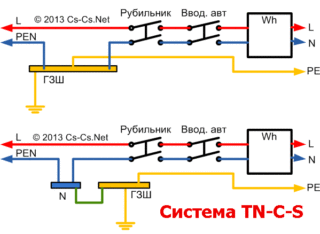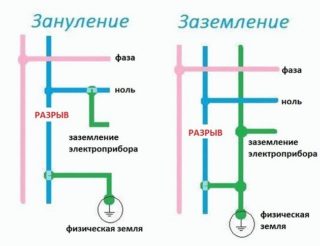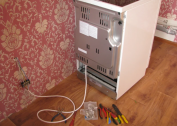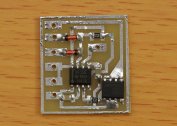Almost everyone has heard of such a method of protection against electric shock, as the grounding of electrical equipment. Installation of a three-wire electrical line in modern building structures is a prerequisite. In old buildings, such a protection system was not used. In this case, electricians resort to grounding wiring.
Why grounding is needed
From the normative documentation of GOST No. 12.01.009-76 it follows that protective grounding is the creation of a single circuit with earth and metal current-carrying parts, which during operation of electrical devices can be energized, for example, the body of a microwave oven or washing machine.
Grounding is required so that when voltage forms in places where it should not be, electricity goes into the ground. This helps prevent electric shock to residents of the apartment or house. As a rule, such phenomena are observed in violation of the integrity of the insulating layer and touching the current-carrying core of the housing.
Types of grounding in the home
 In domestic conditions, a properly implemented grounding system ensures the smooth operation of all electrical appliances. During the existence of the Soviet Union, there was not a large accumulation of electrical installations in houses, therefore, such a safety measure was practically not used.
In domestic conditions, a properly implemented grounding system ensures the smooth operation of all electrical appliances. During the existence of the Soviet Union, there was not a large accumulation of electrical installations in houses, therefore, such a safety measure was practically not used.
At that time, the TN-C system was widely used, in which the PE grounding wire was connected with a working zero to a single PEN conductive core, and a two-wire wire was connected to the apartment. This system is outdated, a new one has replaced - TN-C-S. Its feature is that the PEN wires on PE and N are disconnected in the switchboard.
All modern buildings or structures subject to modernization are serviced by a three- or five-wire circuit. Three lines are fed into the room:
- land;
- working zero;
- phase.
All computing and household appliances of a modern type are adapted for a three-wire system. Plugs and sockets are equipped with special grounding terminals.
If the building is outdated and is not equipped with a grounding system, and the wiring is two-wire, all modern three-wire electrical devices lose their quality. For example, a surge protector becomes an ordinary carry. In this case, the installation of grounding in the apartment according to the regulatory document PUE 1.7.132 is prohibited.
What is the zeroing of electrical appliances
 From the normative documentation of GOST No. 12.01.009-76 it follows that grounding is a deliberate electrical connection with a protective conductor of non-conductive parts of electrical equipment that may be energized as a result of malfunctions.
From the normative documentation of GOST No. 12.01.009-76 it follows that grounding is a deliberate electrical connection with a protective conductor of non-conductive parts of electrical equipment that may be energized as a result of malfunctions.
There is a concept - grounded neutral. 3 phases come to transformer substations via power lines. Dummy neutral is its own ground, which is installed around. It goes from the substation to residential buildings and buildings with phase wires.
Zeroing is implemented as follows: in the distribution panel, a wiring is made that goes from a grounded neutral and is broken in front of the machine to zero, which goes to the apartment. In essence, this will remain a grounded neutral, which is used for grounding.
It is forbidden to pull equipment from a working machine, it is life threatening.
If the process of neutralization is successfully completed, when you touch the enclosure of the switched-on device with a live exposed conductor, a short circuit will occur and the machine will automatically work at the entrance to the apartment.
Grounding and grounding - what is the difference
Both protection systems perform the same function - they protect households from electric shock when touching a bare wire or faulty electrical installations. The difference lies in the fact that the grounding instantly de-energizes the room in case of a dangerous contact, and grounding removes all the "danger" to the ground.
Application Difference
 The basic rule that all electricians should know is that it is forbidden to simultaneously implement both methods of protection. If it is possible to organize grounding, consider the option of grounding is not worth it.
The basic rule that all electricians should know is that it is forbidden to simultaneously implement both methods of protection. If it is possible to organize grounding, consider the option of grounding is not worth it.
- In multi-unit buildings, grounding is mounted on two sides of the building or around. Old buildings are for the most part exceptions; they may not have a contour at all. In country houses, the implementation of the grounding loop is the homeowner's concern. As a rule, the ground loop has a triangular shape.
- Protective grounding in apartments is used only in the absence of grounding. As a rule, we are talking about old-style apartment buildings. Implementing this method of protection, it is additionally required to purchase and install automatic machines and RCDs.
In industrial sectors, grounding is one of the components of the general grounding of large rooms and all equipment located in them. Zeroing in domestic conditions is not a completely safe way of switching the grounding circuit of electrical appliances to working zero.
What's better
Grounding in comparison with grounding has a large number of advantageous features.
- Grounding circuit can be implemented independently at home. This will require a small amount of metal and a welding machine. If we talk about zeroing, then the implementation of protection requires knowledge that is associated not only with the calculations, but also with the choice of the most suitable point for connecting the wire to the neutral.
- If the neutral wire breaks in the switchboard, the grounding system will immediately fail and will be inoperative. Grounding in this case is superior because the PE wire used does not boil or burn out. It is recommended to check its condition once a year and tighten the terminals if necessary.
Thus, it is better to give preference to grounding, as it is more efficient and easier to implement. You can do it yourself without any special skills.
Grounding and Grounding Requirements

The main requirement is the correct implementation, which will ensure complete safety and protection of a person from electric shock in case of emergency or emergency situations.
The main requirements for grounding are the removal of voltage into the soil layers. Earth absorbs electric current, preventing damage to human health.
Zeroing requirements - disable protective automation if current-carrying elements or exposed wires come into contact with the surfaces of metal housings of electrical components and household appliances where there should be no voltage.
Practical tips
With the full or partial replacement, modernization or repair of wiring in an apartment or a country house, it is important not to neglect the rules of personal safety. A few practical tips:
- If a two-wire electrical network is installed, when installing a three-wire outlet, do not connect the ground loop and the working zero. This is a violation of one of the basic safety rules.If you neglect it, the case of a household appliance connected to the network will always be energized, which negatively affects productivity and operational life, and also carries a danger to the life and health of humans and pets.
- During the construction of a summer house or a country house, the installation of grounding is a prerequisite for the operation of electricity. An inexpensive grounding system with a simple design will save people's health and the integrity of all expensive household appliances, electrical appliances.
- To provide power to powerful household appliances, for example, a washing machine or dishwasher, boiler, it is recommended to conduct a separate electrical wiring line in the room. This is due to the fact that when these devices are started at the same time, RCD sensors (residual current circuit breakers) and safety sensors will often trip, completely shutting off the supply of a resource to an apartment or house.
A safety circuit breaker and an RCD are two completely different electrical devices. Each of them has its own design features and performs certain functions.
The protective shutdown device is a protection for humans and pets, a quick-acting device. An automatic machine is an electrical device that captures changes in the parameters of an electric network, in particular its overload. Its main drawback is that it may not work right away, but after a certain time. To combine the capabilities of the two protective devices and level out their shortcomings, a hybrid device was developed - difavtomat.





